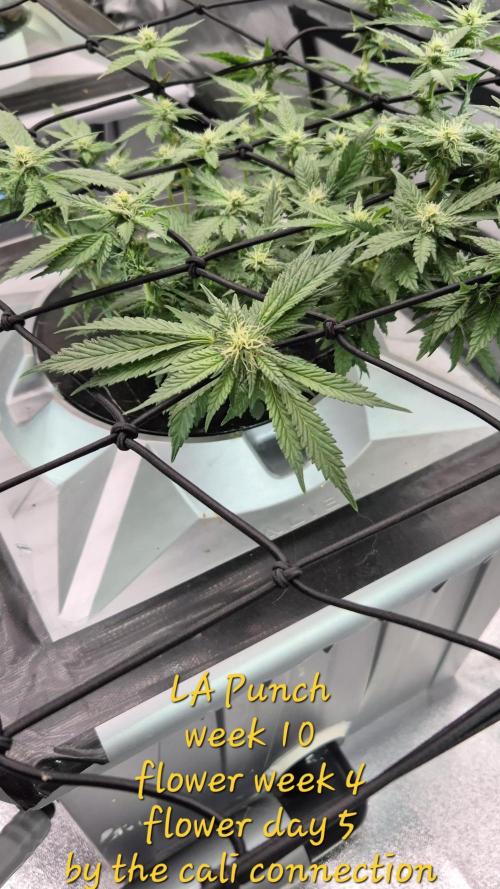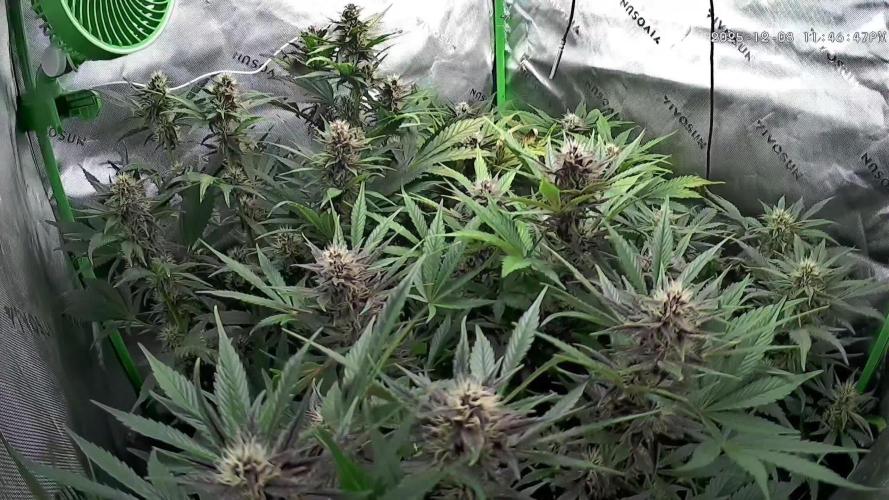The Grow Awards 2026 🏆 





























Processing
Likes
Comments
Share


@Pardy
Follow
The flowering went down under great conditions. Everything went pretty alright with this grow and I'm satisfied with the result. It was my second time growing this strain first outdoor however. The colas looked amazing. The plant didn't get too tall and stayed bushy. Good thing however as I was trying to keep it discreet. The smell wasn't an issue either.
Likes
15
Share


@valiotoro
Follow
Hello everyone 👋
Week 1 has passed
She’s doing very well growing at fast pace with a beautiful green color on the leaves🔥
For the nutrient 1/2 plagron terra grow & B.A.C foliar spray 4ml/L once a week💦
See you next weed😎
Likes
24
Share


@Lowkey_Doc
Follow
I didn’t join Grow diaries until this week so here’s where I am at!
I plan to stay using this, I respect the community it feels like home, any way about the grow...
WALTER WHITE/ MEPHISTO
I have grown this plant before and she is definitely one of my favorite strains from Mephisto.
It has a citrus, berry smell.
The smoke is smooth and creamy.
Week 4; Day 25 of flower(update)
~Average~
Temp: 76-83
RH: 42%-52%
PH: 5.9-6.2
NOTES: This week the trichrome production was on the run. They started to put on.
I am happy with the smell in the grow room/ tent.
I notice some tip burn so I am going to give two waters at a ph of 6.0 then go back to the schedule.
I am hoping these ladies do me as well as the first run I had with them!
Happy growing, Gromies🤙🏽
Week 5
Likes
Comments
Share


@madlangs
Follow
No problems
8.11.25
WW 54cm and 34cm
Pineapple 34
Afgooey 41
n lights 48cm & 67cm
Sleepy Joe 54cm
Papaya zoap 68cm
Pure glitter 26cm
Ppfd 950
Likes
8
Share


@RBG
Follow
Week 10
Flower week 4
Flower-day 1
05/11/2025
Nutrients change
Floramax veg1
Floramax Organabud
Floramax flowering enhancer
Floramax Rezin
Cyco platinum series silica
Green planet bud booster
Complete grow cal mag
( sensi unfortunately got refunded so got this instead today )
Sleeps with the fishez ( hocI )
E.c 2.4-2.5, ph 6.1
Ladies are looking good overall, let the fun goodness begin i guess 😂
7/11/25
Blockage within systems finally fixed after 4 flushes. Not exactly sure what it was but whatever ive done has fixed it for now 🤷♂️😂 take it as a win for now i guess
11/11/25
Dont like scrogging, removed. Have placed lst back on for now to get light into the middle, hopefully also tricks them to shoot up a little more, who knows.
Over LA Punch is doing fanatic.
For my first photo grow and rdwc grow after 3 learning attemps. Ive done well and have gotten pretty far. I think off this lady, I'll be surprised about her yield she is staking on quality nicely like the Cherry, the grape unfortunately is struggling right now
Likes
7
Share


@420keef
Follow
Finally got myself a dehumidifier, now i can controll the humidity in my room because it often went above 60% 🤷♂️🏻 Also love how the big northern light is really packing some weight! & the buds on the bottom look as good as the ones more on top!! Can’t wait till i can harvest all of em😁
Likes
18
Share


@EaRtH
Follow
24.10. - Today I've switched the LST technique. I've drilled a few holes to the pots and tied down my plants. One of them is significantly stronger and bigger. I'm wondering if it's because of genetics or if I did something wrong that slowed down the others.
26.10. - Plants started to show first signs of pre flowering stage. I've decided to completely untie the smallest plant as I don't think there will be much yield at all. Other two are growing pretty fine, branches are getting longer and thicker. I will slowly decrease the amount of Bio Grow and start to add a bit of Bio Bloom to the mix.
30.10. - All plants are showing nice improvements. Branches gained on height and got thicker. I can already see some bud sites developing, so I've decided to completely replace Bio Grow with Bloom.
24.10. - 30.10.2023
Likes
8
Share


@STAYINGONMYMAINCBATORUNTWO
Follow
This girl was drinking a lot slower than the others I’m guessing she’s cooler in that corner at the base but either way growth was slower into bloom but now she has shot to an impressive 22-23” levelling out the canopy at the back! Can’t wait to see how these flowers form!
Likes
22
Share


@DogDoctorOfficial
Follow
🌸 Week 15 from Seed / Week 4 Flower – The Art of Defoliation 🌿
Welcome back to the journey of The White OG by Seedsman Seeds. This week marks a powerful turning point — the mid-flower defoliation — a sacred act of giving space, light, and breath to a girl who’s ready to bloom big.
She’s thriving beautifully under the Future of Grow Black Series 600W system, and still running strong on the Aptus Clean Program:
• Regulator
• System Clean
• RO Water Conditioner
• All-in-One Liquid
The mix lands with a pH of 5.97, an EC of 1.20, and water temp at 18.2°C — right on point.
🌬️ This week’s star event? A serious defoliation.
We removed large fan leaves that were shading critical bud sites, allowing light to pour in and airflow to circulate. This isn’t just pruning — it’s breathing room. It’s strategy. It’s sculpting the future.
She’s expressing herself now some funky leaf formations, even buds forming in the leaf base itself, a unique phenotype with personality. This is what makes each grow magical.
Why defoliation now?
• Week 4 is the sweet spot: flowers are forming, stretch is slowing, and now’s the time to open up the canopy without stressing her too much.
• It increases light penetration and reduces risk of mold or pests by improving airflow.
• It directs energy to the buds, not the blocked, lower leaves.
And now she stands proud in her scrog net, breathing deep, stretching wide. She’s no longer hiding. She’s becoming.
⸻
Huge thanks as always to the amazing GrowDiaries community, to Seedsman, to Aptus Holland, to the Future of Grow team, To TrolMaster and to all of you: the followers, supporters, growers, learners, lovers, and even the haters — we grow together 🌱
💚 Come join the journey over on Instagram and YouTube — where the Dognabis Cup is blooming into something beautiful too.
See you in the next chapter, my dear friends. Let’s grow.
As always thank you all for stopping by, for the love and for it all , this journey of mine wold just not be the same without you guys, the love and support is very much appreciated and i fell honored and so joyful with you all in my life 🙏
With true love comes happiness 💚🙏 Always believe in your self and always do things expecting nothing and with an open heart , be a giver and the universe will give back to you in ways you could not even imagine so 💚
Friendly reminder all you see here is pure research and for educational purposes only
💚Growers Love To you All and remember to keep that smile big and alive 💚
Likes
4
Share


@JeyGanesha
Follow
Ieri 24/7/2025 ho messo fuori in giardino del mio brother questa matanuska....qui dovrebbe esplodere 😂😉👍💪.spero che in questi 2 mesi di fioritura ci siano belle giornate di sole da dare alla pianta tutto il fullpower che ha bisogno,💪🙏
Likes
5
Share


@CreamyNuggets
Follow
So far all plants have been harvested. (3x Bubba Pupil, 1x purple wreck, 1x AK-47, 1x Godberry). The first bubba pupil and AK-47 were harvested a week and a half ago and now have been jarred for 1 week +/- a few days. All pictures are of the bubba pupil and AK. I will come back and update once the other plants have been trimmed.
The first Bubba Pupil, which was the tallest of the 3 and most stretched out, yielded exactly 4.5 Oz dry weight. The smell is starting to get stronger after a week. It smells grapey but has a weird funk to it. It must be the “pupil” funk everyone talks about. This plant looked like it wasn’t going to yield much, but I was pleasantly surprised. The lowers were dense and compact which contributed to a good amount of decent sized buds. Overall, I’m pretty pleased with the yield and quality from this plant.
The AK-47 seemed like it was going to be a heavier yielder, but it ended up only yielding 2.5 Oz dry. The main colas were far during flower and dense when dried, but this plant had little to no lower quality buds. Everything below the main canopy seemed like it was airy and not worth jarring up. This plant smells a little bit fruity, but I can’t really put my finger on it. Super dank smelling, not skunky, but it smells like it is going to be gaseous once it cures up a bit longer.
The Godberry yielded a total of 3.25 Oz. She was the best smelling by far out of all of the girls in the tent. Super fruity and sticky as hell. The resin content on her was definitely the highest of them all.
I will be back to update once the last 3 plants are trimmed and jarred for a final weight and overview.
Likes
14
Share


@ShinWeed
Follow
.
Vorwort:
Die Pflanzen zeigen deutliche Mängel, was zum jetzigen Zeitpunkt erwartet wurde. Seit heute gibt es nur noch Wasser und natürlich PH reguliert, ca. 4-5 Liter, ohne Dünger. Weitere Mängel in den kommenden Tagen sind eingeplant und kein Grund zur Sorge. Die Ernte ist für nächsten Montag oder etwas später vorgesehen.
🌿 Woche 8 - Reifephase, Substanz vor Optik
Ich, Banana Purple Punch, stehe am Ziel. Meine Blüten sind schwer und dicht, meine Energie ist vollständig in sie geflossen. Die Blätter lassen nach, Farben verblassen, aber das gehört dazu. Mein Duft ist voll entwickelt, süß und tief. Ich brauche nichts mehr außer Zeit. 🍌
Ich, Purple Haze, bleibe konstant bis zum Ende. Meine Struktur ist stabil, meine Blüten reifen gleichmäßig weiter. Die Mängel zeigen sich ruhig und kontrolliert. Mein Duft ist klar, würzig und präsent. Kein Drama, kein Einbruch.
Wir beiden Lemon Cherry Cookies nähern uns auf unterschiedliche Weise dem Abschluss.
Ich, die Schnellere, zeige deutliches Finish-Verhalten. Die Buds sind kompakt, die Mängel nehmen zu, die Energie geht sichtbar zurück. Mein Duft ist intensiv, süß-sauer und deutlich ausgeprägt. 🍋🍒
Und ich, die Ruhige, bleibe gelassen. Meine Entwicklung ist weiterhin gleichmäßig. Mängel sind vorhanden, aber ohne Stress. Ich nehme mir die Zeit, die ich brauche.
Woche 8 fühlt sich nach Loslassen an.
Kein Nachjustieren mehr, kein Eingreifen. Wasser, Licht und Geduld. Die Pflanzen bauen ab, um abzuschließen. Genau so ist es gedacht.
Likes
16
Share


@eldruida_lamota
Follow
Esa familia , estamos otra vez y aquí actualizo la quinta semana de floración de las BlueBerry Cheese del banco de semillas ZambezaSeeds.
Estas tienen buen color y el proceso de floración es el correcto su progreso es increíble.
Ahora empezaré a aplicar el ExplotaCogollos de Agrobeta que es Brutal como compacta las flores , palabra.
Que ganas ya de acabar estos proyectos y empezar con cosas serias.
Os adelanto que lo próximo que que viene son Gelato y Lava Cake, y después Titán F1.
Agrobeta:
https://www.agrobeta.com/agrobetatiendaonline/36-abonos-canamo
Mars hydro:
Code discount: EL420
https://www.mars-hydro.com/
Las maximas de temperatura no superan los 26 grados y las mínimas no bajan 20, así que no me puedo quejar.
Los niveles de humedad también son los correctos van entre 50%/65% de humedad relativa.
Por supuesto el Ph lo estamos dejando alrededor de 6.
Hasta aquí es todo, buenos humos 💨💨💨.
Likes
12
Share


@Hydronaut
Follow
Big fuck up programming Wi-Fi switches and mapping sequences! Water was actually ph up:| Had to flood and rinse with plain water 4 times:(
Likes
23
Share


@Herbman420
Follow
This week went well for the two jet fuels I'm really happy with them because I wasn't too sure how they would be. even though they're from the same parents they are too completely different phenotypes that I can see. different structure and shape to the leaves obviously very unstable genetics but gives me something new to see as well . I'm very interested to see how they are going to turn out . Thank you for looking at the diaries and for any more updates on the summer grow please look at the comments in my main profile. Have I have a good day everyone and see you next week




























